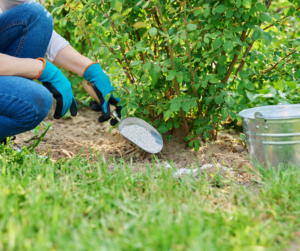Abiotic Issues in Your Garden & How to Overcome Them

There are some things you can choose when gardening, and there are others that are out of your control. You can choose what to plant, where to start your garden, and which fertilizers to use. Unfortunately, to many gardeners’ dismay, you are unable to control many abiotic issues from arising, though you can prepare yourself for these problems. Abiotic means something is physical rather than biological (biotic). For example, weather events in your garden are abiotic, while pests are biotic. Today, we will review the most common abiotic issues in your garden and how to overcome them.
Abiotic Issues in Your Garden
Problem: Drought
A drought is a prolonged period of low rainfall, leading to a water shortage. In your garden, this means your plants aren’t getting the water usually supplied by Mother Nature. In addition to watching the forecast and noticing the lack of rain, you might see the following signs of drought stress:
- Wilting leaves that do not revive in the evening (usually caused by sunlight during periods of normal rainfall)
- Curling, yellowing leaves
- Unexpected fruit drop
- Browning and scorching of leaf tips
Solution: Addressing drought in your garden is simple: all you have to do is add water yourself. As a general rule of thumb, your garden should get about 1″ of water a week. Some plants like more water than others, so research the specific plants you’re growing.
Problem: Waterlogging
Opposite of drought, waterlogging is when your soil has too much water. This is caused by natural flooding or over-irrigation. It causes air displacement in the soil and can even change the soil processes, leading to the accumulation of toxic substances. You might be dealing with waterlogging if you notice:
- Water ponding on the surface of your soil
- Water that doesn’t drain, causing it to look wet and glistening
- Algae on the surface of your soil
- Yellowing crops
Solution: Unfortunately, the only thing you can do after a waterlogging event is wait it out and skip any watering until the soil is dry again. Then, make sure you take steps to avoid waterlogging next year like growing in raised beds and improving soil structure.
Problem: Hypersalinity
Water salinity refers to the amount of salt in the water, and hypersalinity means there is too much. Hypersalinity is often caused by insufficient watering, which prevents ions from leaching from the soil profile. You might be dealing with this abiotic stress if you see:
- Leaves that are bluish-green and darker than expected
- Stunted growth
- Short internodes on stems
Solution: It takes time to reduce hypersalinity in your garden, and unfortunately there aren’t any amendments you can use. The best way to address it is to ensure there is good drainage in your water that allows salts to be washed out. This might mean creating a slope in your garden if it’s on flat land.
Problem: Wind
Look outside, and if you see wind whipping plants around, you might end up with a problem in your garden. Signs of wind stress include:
- Wilted leaves and brown edges
- Ripped leaves
- More water needs than usual
Solution: You can’t control the wind, but you can take steps to protect your plants. Sturdy plants like bushes nearby will take the brunt of the wind. Or you might set up your garden next to a wall or fence. If you live in a particularly windy area, you might want to consider planting in pots that you can move around to the best location as needed.
Problem: Nutrient Imbalance
Your plants need the right balance of macro-nutrients and micro-nutrients to thrive. Your plants won’t be as successful if things aren’t quite how they should be. Signs you are dealing with nutrient imbalance include:
- Yellowing leaves
- Yellow or brown leaf edges
- Reduced growth
- Leaves with a purple or red tone
- Spots on your leaves
Solution: These signs of nutrient imbalance can overlap with signs of other issues in your garden. You can send your soil off to a testing lab to get a thorough evaluation of the nutrients. You can also be sure to fertilize at the right times with the right amendments, dependent on the plants you have in your garden.
Combat Abiotic Stresses with Harvest Hero
Harvest Hero makes a variety of inorganic soil amendments to help gardeners grow stronger, healthier plants that are better able to withstand abiotic stresses. Our Harvest Hero Enhanced Perlite Mix is a nutrient-rich inorganic amendment and growing medium that is a 3-in-1 blend comprised of perlite, diatomaceous earth, and essential nutrients. This patent-pending mix has been designed by Harvest Hero’s team of engineers and agronomists to improve soil structure for nutrition which promotes bigger plants and bigger yields. Harvest Hero Enhanced Perlite Mix will improve soil quality, provide plant nutrients, and amend soil properties to make it easier for the plant to absorb and translocate essential plant nutrients to the root system.
Explore our soil amendments today to discover which is best to support the health of your garden.



